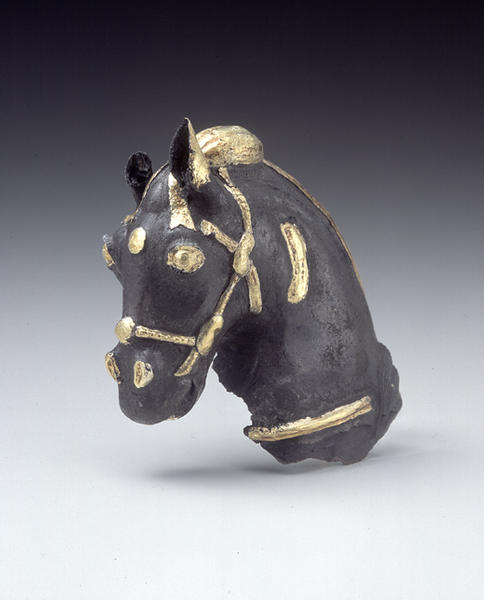馬形リュトン断片
- バクトリア
- 前4世紀-前2世紀
- 鍍金銀
- H-7.7 D-2.5 W-6.5
金製・銀製容器(古代バクトリア遺宝展)
バクトリア遺宝で容器は大きな部分を占め、22点の金器(作品123~144)、26点の銀器(作品97~122)が含まれる。銀器の中には背の高いアケメネス朝の灌頂用ゴブレット型をしたものが6個(作品103~106、108、109)あるが、その装飾はヘレニズム期の特徴をもっている。これに似たカップを、線刻や押し出し技法で奉納金板に表された神官が持っている。同様に灌頂用のリュトンが5個(作品116~119、122)あるが、その内3個(作品118、119、122)は器前方の断片である。更に8個の銀製灌頂用浅鉢(作品97~99、101、102、111~113)があるが、金製の器と同様の目的に使われた。18個の金製灌頂用鉢(作品123~140)は等しく丸い底と広がった縁をもっている。ピクシス型をした容器(作品142)は蓋がついており、これらの器の中では一番古い部類に属している。特に興味深いものは香炉(作品141)で内側に四つの環が付き、これに紐をとおして提げたものであろう。
これらの器は概して大英博物館のオクサス遺宝よりも大振りであるが、同じ用途に使われたものと思われ、ペルセポリスの浮彫に刻まれた人物が持つ器に近い形状をしている。この関連からこれらの器の年代を考えることができる。これとともに、ペルセポリス型のゴブレットやリュトンを作る光景が、エジプトのヘルモポリス・マグナにあるペトシリスの墓のプロナオスに浮彫で表されていることは特筆に価する。マスカレラによれば、この浮彫は前300年頃の鍛金工房の様子を描いたものに相当する。
牡鹿形リュトン
香炉
ロゼット文浅鉢
ロゼット文浅鉢
ロゼット文フィアラ杯
ロゼット文鉢
フィアラ杯
ロゼット文浅鉢断片
ロゼット文鉢
ロゼット文鉢
ロゼット文鉢
ロゼット文鉢
ロータス・パルメット文鉢
ロゼット文鉢
人頭装飾鉢
ロゼット文鉢
植物文杯
ケートス文皿
鉢
人物装飾鉢
獅子頭形杯
馬形リュトン
ラマッス形リュトン断片
双獅子形柄杓装飾
円盤(鏡)
ライオングリフィン形リュトン断片
浅鉢
浅鉢
浅鉢
鉢
鉢
鉢
鉢
鉢
鉢
鉢
鉢
鉢
鉢
鉢
鉢
鉢
鉢
鉢
蓋付鉢
解説(古代バクトリア遺宝展)
前5世紀
鍍金銀
高7.7 cm 幅6.5 cm 奥行2.5 cm
馬の頭部を象ったリュトンの断片か、何かの端飾であったものかと思われる。馬具には円形の飾りの他、4カ所にアケメネス朝美術によく見られる猪牙形をした装具がつけられている。頭頂には、額に両端を垂らしたリボンで束ねられた冠毛が丸く盛り上がり、それに続く鬣は短く刈り込まれ、首の付け根付近の左側に垂れた長い房を残している。この鬣の表現もアケメネス朝美術の典型的な様式である。これら鬣、馬具、目、鼻、前歯などには鍍金を施している。
Catalogue Entry
5th century B.C.
Gilded silver
H. 7.7 cm, W. 6.5 cm, Depth 2.5 cm
This horse head is thought to be either a fragment of a rhyton, or its finial decoration. The harness is decorated with round designs, and there are four instances of boar tusk-shaped decorative harness elements, a form frequently seen in Achaemenid period arts. The forelock is tied into a round protuberance with ribbons which hang on either side of the forehead. The mane which runs back from this forelock is cropped short, with a long tuft of mane remaining hanging down the left side at the base of the neck. This mane expression is also the typical form seen in Achaemenid period arts. These elements of the mane, harness, eyes, nose and front teeth have been gilded.
Vessels
The "vessels" division is represented by a relatively large number of objects.There are 22 items of gold (cat. Nos. 123-144) and 26 of silver (cat. Nos. 97-122). Among the silver vessels, there are 6 goblets (cat. Nos. 103-106, 108, 109) tall libation vessels Achaemenid in form, but decorated in a style which is typically Hellenistic. Similar cups are held by the magi represented on the relief sculptures and votive plaques. Three rhyta made for a similar purpose are unfortunately in a fragmentary condition (cat. Nos. 118, 119, 122). In addition there are 8 shallow bowls (cat. Nos. 97-99, 101, 102, 111-113) for ritual libations. The gold vessels were used for the same purpose; there are 18 libation bowls, of simple form, most of which have a rounded base and everted rim (cat. Nos. 123-140). One tall vessel of a pyxis type with a lid (cat. No. 142) appears to be the earliest of the vessels in the collection. Of special interest is an incense burner in the form of a censer with four rings for suspension (cat. No. 141).
Although the number of vessels in this collection is considerably larger than those of the Oxus Treasure in the British Museum, they probably served the same function. The vessels of both collections are closely paralleled by the vessels held by worshippers depicted on the Persepolis reliefs. This observation makes it possible to date them. It is worth adding here that the manufacture of goblets of similar shape and of rhyta in the Persepolitan style is depicted on a relief in a pronaos on the northern wall of the tomb of Petosiris at Hermopolis Magna in Egypt. According to Muscarella, the reliefs attest the manufacture of embossed articles in Egypt right up until 300 BC.
牡鹿形リュトン
香炉
ロゼット文浅鉢
ロゼット文浅鉢
ロゼット文フィアラ杯
ロゼット文鉢
フィアラ杯
ロゼット文浅鉢断片
ロゼット文鉢
ロゼット文鉢
ロゼット文鉢
ロゼット文鉢
ロータス・パルメット文鉢
ロゼット文鉢
人頭装飾鉢
ロゼット文鉢
植物文杯
ケートス文皿
鉢
人物装飾鉢
獅子頭形杯
馬形リュトン
ラマッス形リュトン断片
双獅子形柄杓装飾
円盤(鏡)
ライオングリフィン形リュトン断片
浅鉢
浅鉢
浅鉢
鉢
鉢
鉢
鉢
鉢
鉢
鉢
鉢
鉢
鉢
鉢
鉢
鉢
鉢
鉢
蓋付鉢
